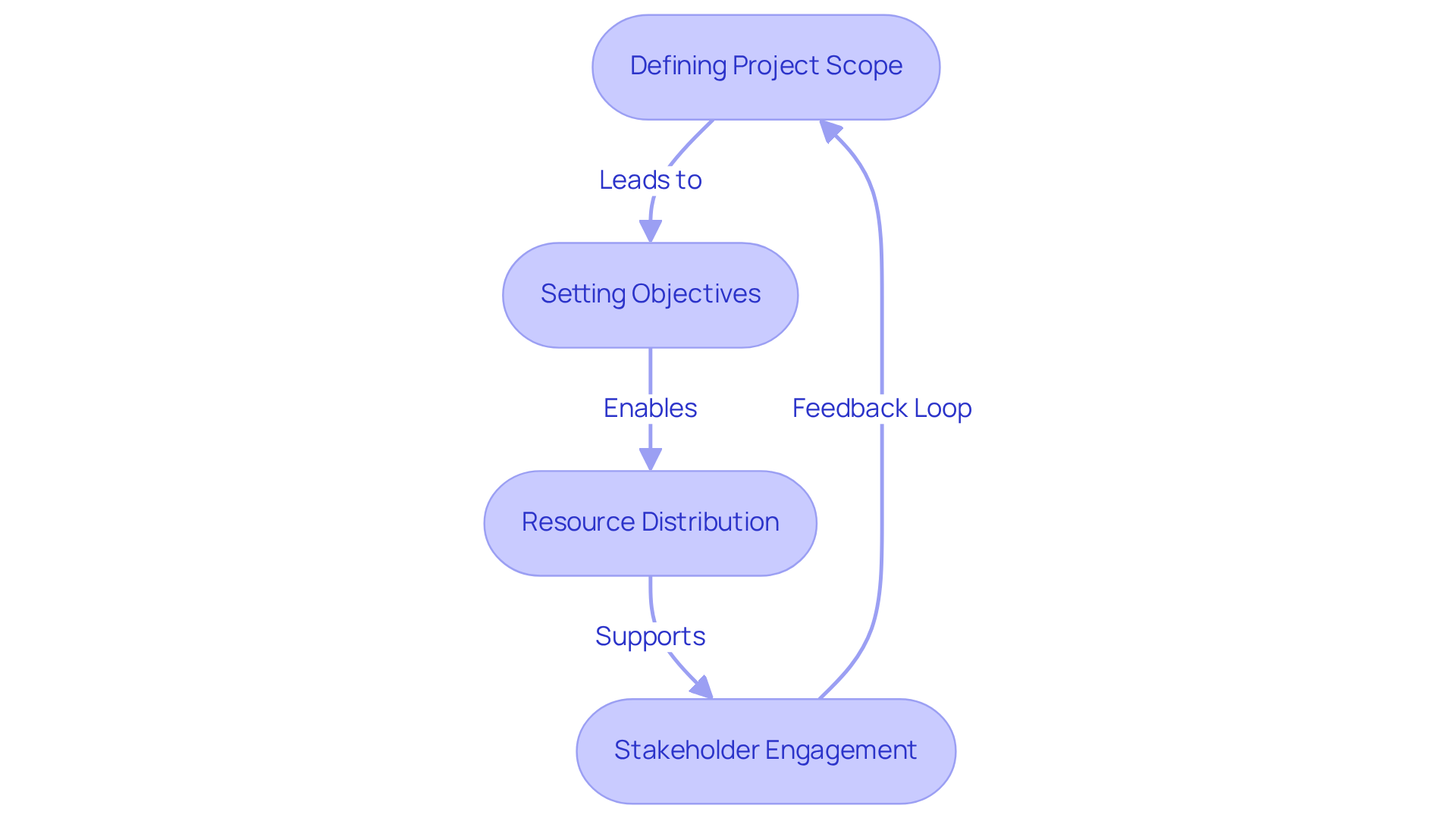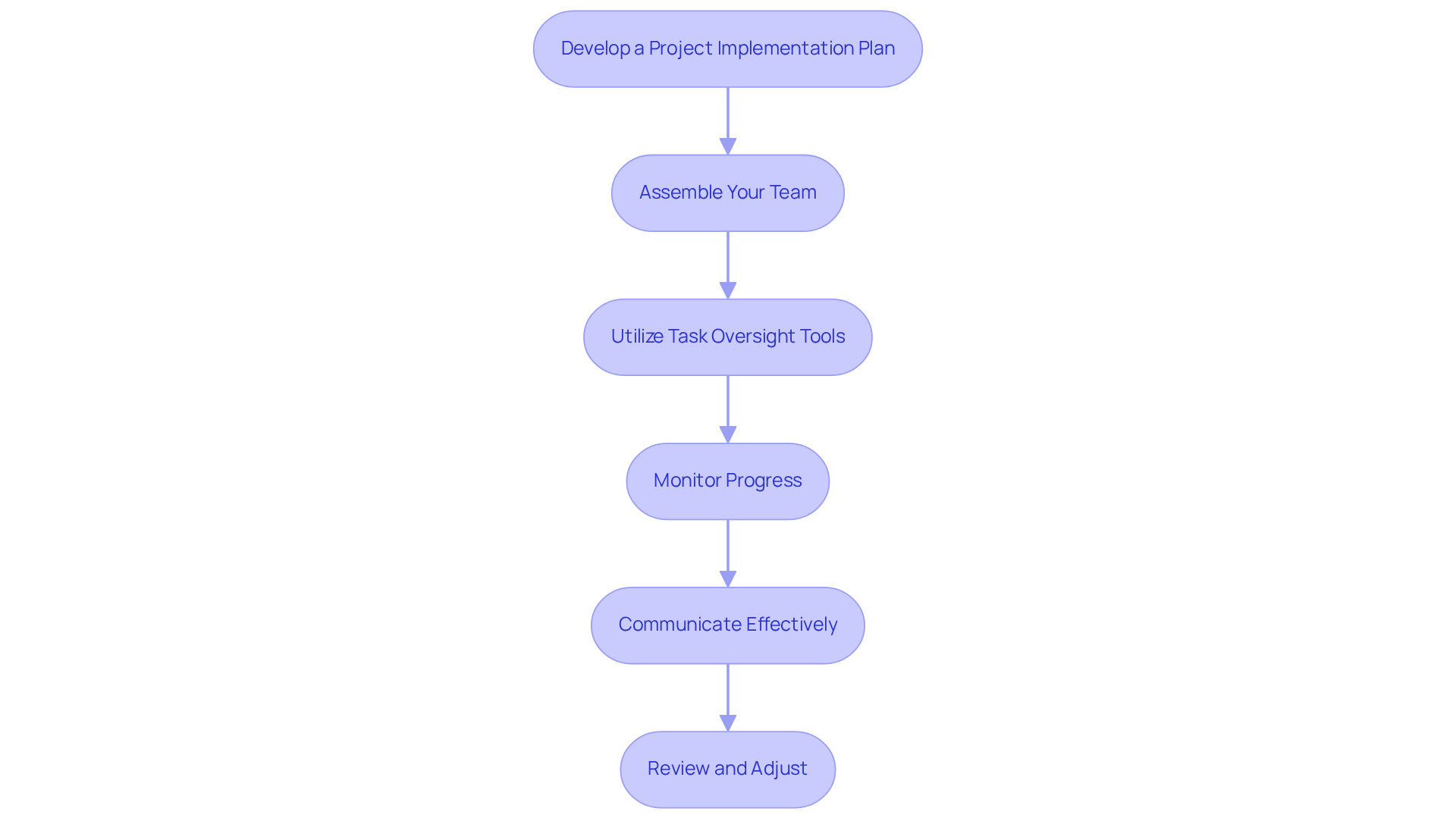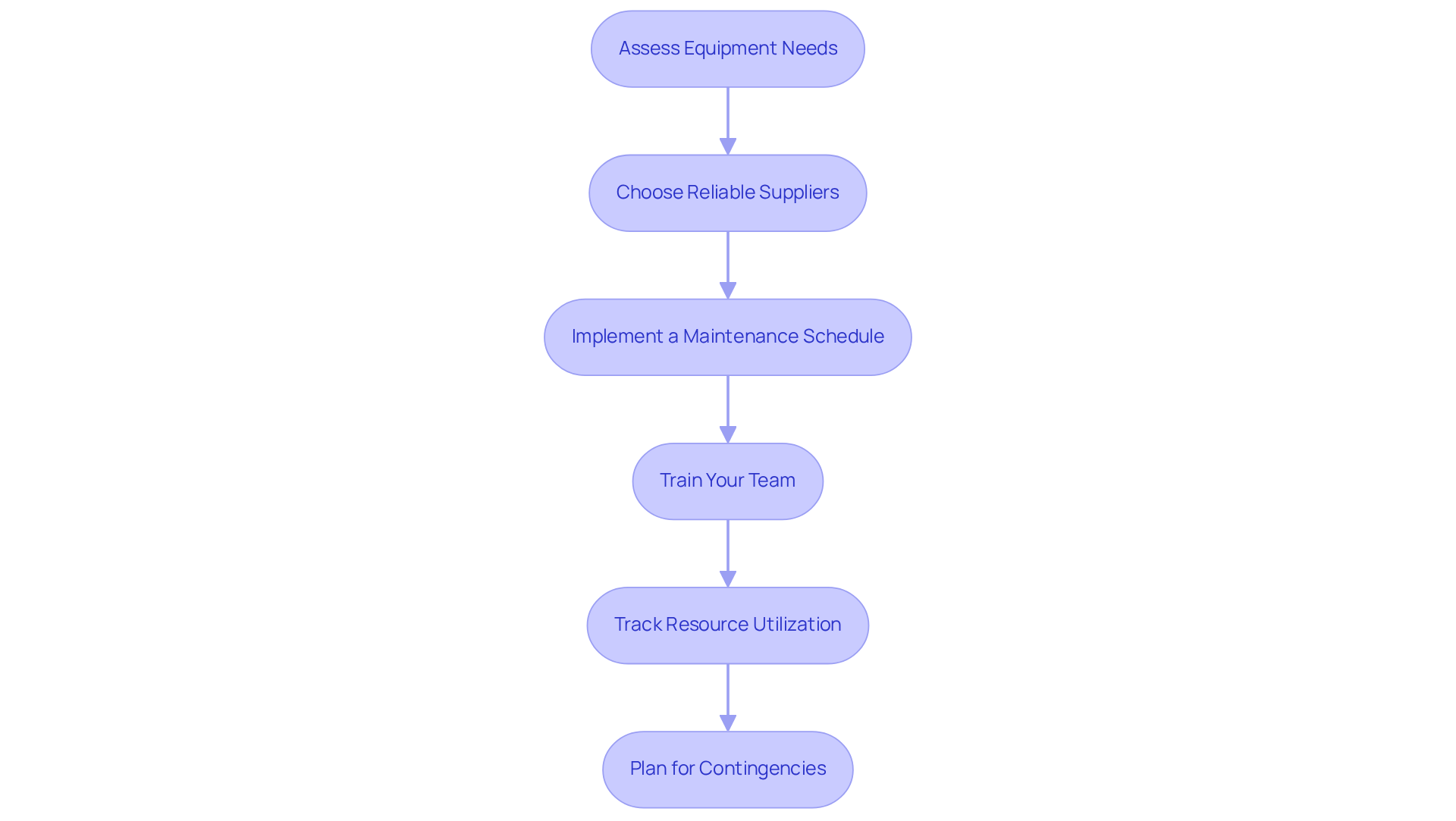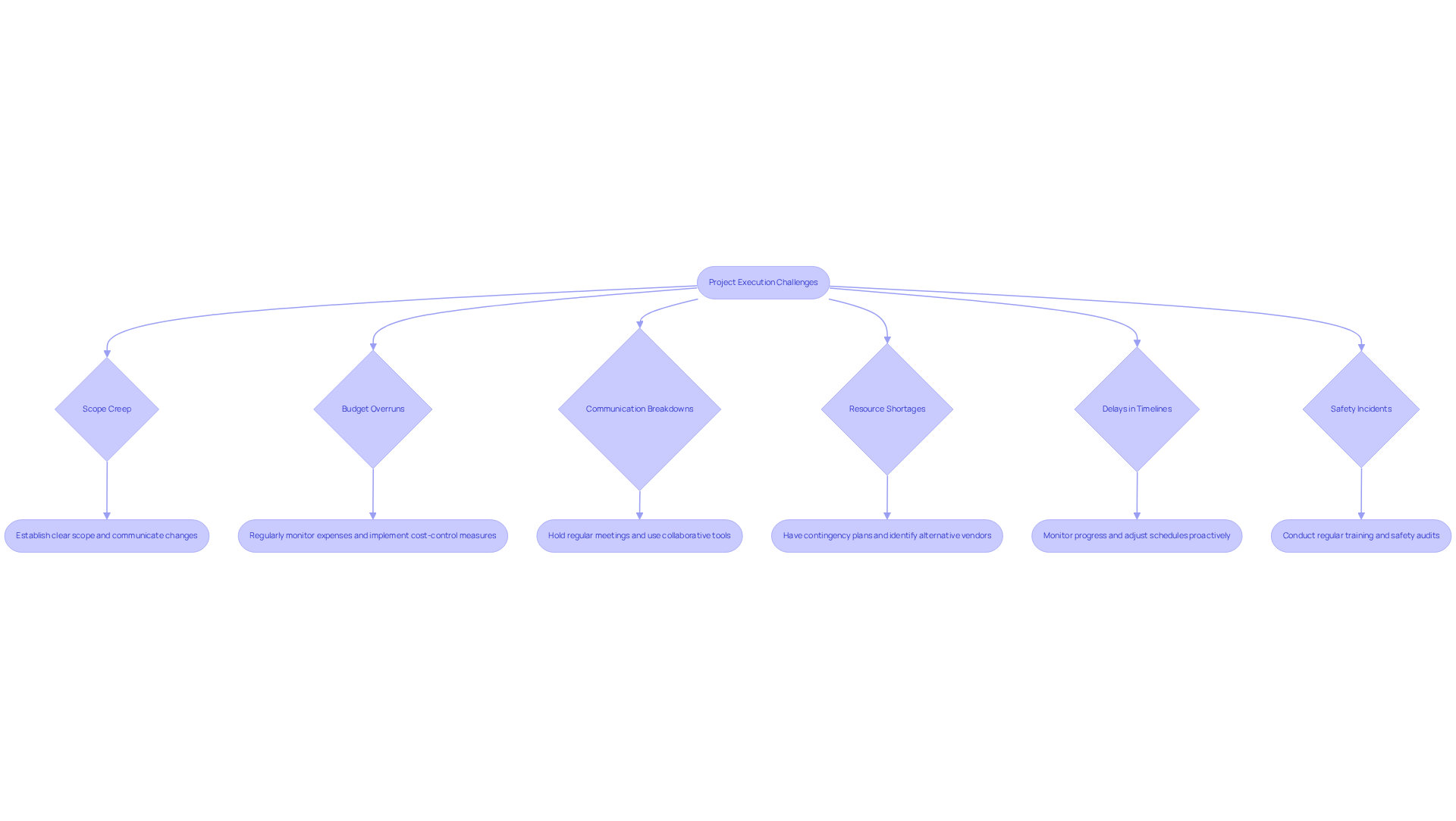Overview
Successful project execution with effective equipment solutions is fundamentally rooted in a clear project scope, measurable objectives, and engaged stakeholders. These critical elements significantly reduce risks and enhance outcomes. Evidence supports the assertion that well-defined project parameters, coupled with active communication, can effectively mitigate common challenges such as scope creep and budget overruns. This ultimately leads to a higher likelihood of project success.
In addition, the importance of stakeholder engagement cannot be overstated. Engaged stakeholders contribute to a collaborative environment where feedback and insights can be shared freely. This active participation not only fosters a sense of ownership but also enhances the overall project experience. By ensuring that all parties are aligned with the project's goals, organizations can navigate potential pitfalls with greater ease.
Furthermore, the integration of reliable equipment solutions plays a pivotal role in achieving project objectives. By utilizing high-quality tools and machinery, teams can operate more efficiently, minimizing downtime and maximizing productivity. The right equipment, combined with a strategic approach to project management, sets the stage for successful outcomes.
In conclusion, prioritizing clear communication, stakeholder engagement, and reliable equipment solutions is essential for successful project execution. Organizations are encouraged to adopt these best practices to enhance their project outcomes and ensure a smooth operational flow.
Key Highlights:
- Implementation is the phase where project plans are executed to achieve objectives, involving organisation and resource management.
- Defining project scope is crucial to avoid scope creep and mitigate delays; 70% of initiatives fail due to unclear requirements.
- Setting measurable objectives increases the likelihood of success; initiatives with clear goals are 2.5 times more likely to succeed.
- Effective resource distribution minimises waste; organisations with structured management practises waste 28 times less money.
- Engaged stakeholders are vital for project success; 62% of successful projects had supportive sponsors.
- Develop a comprehensive project implementation plan that includes timelines, milestones, and resource allocation.
- Assemble a skilled team with defined roles; successful teams typically consist of 5 to 10 members.
- Utilise task oversight tools to enhance tracking and communication; only 22% of organisations currently use management software.
- Regularly monitor project progress and adjust resources as necessary; structured practises help complete initiatives within budget 63% of the time.
- Effective communication is crucial; 57% of project failures are linked to communication breakdowns.
- Adaptability is essential; high-performing organisations emphasise continuous improvement and agile methodologies.
- Common challenges include scope creep, budget overruns, communication breakdowns, resource shortages, and safety incidents.
- Implementing strong cost-control measures can reduce budget overruns by 40%; 57% of endeavours conclude within budget.
- Prioritise safety by conducting regular training and audits to reduce risks during project execution.
Introduction
Successful project execution represents a complex interplay of planning, resource management, and stakeholder engagement. In this arena, even the slightest misstep can result in costly delays and failures. Alarmingly, 70% of initiatives falter due to unclear objectives and inadequate execution strategies. Thus, grasping the core principles of effective project management is not just beneficial; it is essential.
This article explores the fundamental steps and innovative equipment solutions that can elevate project execution from a daunting challenge to a streamlined success. What strategies can project managers employ to not only meet but exceed their project goals amid the inevitable hurdles?
Understand Project Execution Fundamentals
Implementation is the phase where plans are transformed into action to achieve objectives. This critical stage involves organizing individuals and resources to ensure successful project execution with effective equipment solutions, while effectively combining and executing activities in accordance with the management plan. Key elements include:
-
Defining Project Scope: Clearly outlining what the project will deliver and establishing its boundaries is essential. A well-defined scope not only aids in avoiding scope creep but also mitigates potential delays and budget overruns. Notably, 70% of initiatives worldwide fail due to various factors, including unclear requirements and shifting objectives.
-
Setting Objectives: Establishing measurable goals that align with the initiative's scope is crucial for tracking progress and ensuring accountability. Initiatives with clear goals are 2.5 times more likely to succeed when effective practices are applied. Furthermore, 73% of organizations that utilize formal planning frequently achieve their objectives, underscoring the significance of organized methods.
-
Resource Distribution: Recognizing and assigning essential assets, including personnel, equipment, and materials, is vital for sustaining initiative momentum. Effective resource management can significantly minimize waste, which is crucial for successful project execution with effective equipment solutions, as organizations employing organized management practices waste 28 times less money than those that do not.
-
Stakeholder Engagement: Maintaining open lines of communication with all stakeholders ensures alignment and helps manage expectations. Engaged stakeholders are more likely to support initiatives, with studies indicating that 62% of successfully completed endeavors had supportive sponsors, emphasizing the essential role of engaged sponsors in achieving success.
Grasping these essentials equips you for the subsequent steps in successful project execution with effective equipment solutions, ultimately leading to enhanced outcomes and satisfaction among all parties involved.

Follow Key Steps for Effective Project Execution
To execute a project effectively, consider these essential steps:
-
Develop a Project Implementation Plan: Create a comprehensive strategy that outlines how the initiative will be executed, monitored, and managed. This plan should encompass timelines, milestones, and resource allocation, ensuring clarity and direction throughout the process.
-
Assemble Your Team: Form a skilled task group with clearly defined roles and responsibilities. Research indicates that successful teams typically consist of 5 to 10 members, facilitating effective collaboration while ensuring manageable communication. Each member must understand their specific tasks and how they contribute to the overall goals. Notably, 44% of managers cite a lack of resources as a primary challenge, underscoring the importance of appropriate resource distribution in team formation.
-
Utilize Task Oversight Tools: Employ task oversight software to enhance tracking, task coordination, and communication among team members. Tools that feature Gantt charts and time tracking can significantly improve oversight and help prevent common pitfalls related to delays and budget overruns. It is crucial to acknowledge that only 22% of organizations currently utilize management software, highlighting a disparity in tool usage that can hinder success.
-
Monitor Progress: Regularly evaluate the status of the initiative against the execution plan. Adjust resources and timelines as necessary to ensure alignment with objectives. Research shows that organizations employing structured practice techniques complete initiatives within budget 63% of the time, emphasizing the significance of diligent oversight. However, it is essential to remember that 70% of all initiatives fail, highlighting the stakes involved in effective management.
-
Communicate Effectively: Foster open lines of communication with your team and stakeholders. Frequent updates and feedback cycles are vital for swiftly addressing problems and maintaining momentum. Effective communication is recognized as a key element in success, with 57% of failures linked to breakdowns in this area. As industry specialists assert, 'effective management is crucial to achieving successful project execution with effective equipment solutions and obtaining a competitive advantage.'
-
Review and Adjust: Stay adaptable by being prepared to revise the plan based on feedback and evolving circumstances. Adaptability is essential for successful project execution with effective equipment solutions, enabling teams to tackle challenges and seize new opportunities. High-performing organizations frequently emphasize the importance of continuous improvement and agile methodologies to enhance results. Additionally, management expenses typically range from 7% to 11% of the overall cost, which should be factored into planning and execution.

Leverage Equipment Solutions for Project Success
To leverage equipment solutions effectively, consider these strategic approaches:
-
Assess Equipment Needs: Begin by evaluating the specific equipment necessary for your project, taking into account its scope and complexity. Factors such as size, capacity, and functionality must be considered to ensure optimal performance.
-
Choose Reliable Suppliers: Collaborate with trustworthy rental firms, such as EZ Equipment Rental, to secure access to high-quality, well-maintained tools. Dependable suppliers are crucial; in fact, 40.2% of fleet managers have reported rising maintenance budgets to prolong the useful life of their assets. This statistic underscores the importance of quality in rental partnerships.
-
Implement a Maintenance Schedule: Regular maintenance is vital to prevent breakdowns and ensure safety on-site. Establish a maintenance timetable to keep machinery in optimal condition, as failures can lead to costly delays in construction tasks.
-
Train Your Team: It is essential that all team members receive proper instruction in the use of tools. This training not only enhances safety but also boosts efficiency, enabling tasks to remain on schedule and within budget.
-
Track Resource Utilization: Employ tracking tools to monitor usage and availability. This practice improves resource distribution and minimizes downtime, ensuring that tools are utilized effectively throughout the project.
-
Plan for Contingencies: Always have backup equipment options readily available in case of breakdowns or delays. This proactive strategy guarantees successful project execution with effective equipment solutions, ensuring that your initiative can proceed smoothly without significant interruptions, thereby maintaining momentum and meeting deadlines.

Navigate Challenges and Troubleshoot Execution Issues
Challenges are inevitable in implementation, and understanding how to navigate them is crucial for success. Common issues include scope creep, budget overruns, communication breakdowns, resource shortages, delays in timelines, and safety incidents. Effective strategies to troubleshoot these challenges can significantly enhance successful project execution with effective equipment solutions.
Scope Creep is a prevalent issue that arises when project requirements expand without corresponding adjustments in resources or timelines. To manage scope creep effectively, establish a clear scope from the outset and communicate any changes to stakeholders promptly. Research indicates that 75% of construction endeavors experience scope creep, often leading to budget overruns and schedule delays. Therefore, managing scope creep is essential, as it can lead to unforeseen budgetary increases beyond initial intentions.
Budget Overruns can be mitigated by regularly monitoring expenses against the budget to identify discrepancies early. Implementing strong cost-control measures, such as automated contract handling systems, can result in a 40% decrease in cost overruns. Furthermore, case studies indicate that initiatives with efficient contract oversight strategies can achieve a 30% reduction in delays. It is important to note that 57% of endeavors conclude within budget, highlighting the critical need for effective budget management strategies.
Communication Breakdowns can severely impact project success. Ensure all team members are aligned by holding regular meetings and utilizing collaborative tools. Open dialogue is vital for addressing concerns as they emerge, as inadequate communication can contribute to scope creep and dissatisfaction with the endeavor, with 50% of stakeholders indicating discontent in initiatives influenced by scope alterations.
Resource Shortages can be anticipated by having contingency plans in place. This may involve identifying alternative vendors or adjusting timelines to accommodate delays. Effective asset oversight is essential, particularly in the construction sector, where strict timelines and budget limitations are common. Additionally, 44% of organizations mention cost as an obstacle to cultivating internal management capabilities, which can affect the allocation of assets.
Delays in Timelines can be addressed by closely monitoring progress and proactively identifying potential delays. Adjusting schedules and resources as needed can keep the initiative on track. Studies indicate that 80% of construction endeavors experiencing scope creep face schedule delays, averaging a 33% setback. Significantly, 51% of initiatives are completed on time, emphasizing the importance of efficient management strategies.
Safety Incidents must be prioritized by conducting regular training and safety audits. Fostering a culture of safety awareness among team members can significantly reduce risks and improve overall execution. By addressing these challenges head-on, project managers can enhance their chances of achieving successful project execution with effective equipment solutions.

Conclusion
Successful project execution relies on a deep understanding and effective implementation of key strategies that encompass various facets of planning, resource management, and stakeholder engagement. By concentrating on these critical elements, organizations can significantly boost their chances of achieving project objectives while mitigating risks associated with common challenges.
Essential steps such as:
- Developing a comprehensive project implementation plan
- Assembling a skilled team
- Utilizing task oversight tools
- Fostering effective communication
are foundational practices highlighted throughout the article. Furthermore, strategically leveraging equipment solutions—by assessing needs, partnering with reliable suppliers, and maintaining equipment—is vital for ensuring that projects run smoothly and efficiently.
In light of these insights, it is imperative for project managers to adopt a proactive approach to troubleshooting potential execution issues. By anticipating challenges such as:
- Scope creep
- Budget overruns
- Communication breakdowns
teams can implement measures that not only address these concerns but also promote a culture of continuous improvement. Embracing these best practices will lead not only to successful project execution but also to the cultivation of a more resilient and adaptable organizational framework, ultimately driving better outcomes and satisfaction for all stakeholders involved.
Frequently Asked Questions
What is the implementation phase in project execution?
The implementation phase is where plans are transformed into action to achieve project objectives. It involves organizing individuals and resources to ensure successful project execution according to the management plan.
Why is defining project scope important?
Defining project scope is essential because it clearly outlines what the project will deliver and establishes its boundaries. A well-defined scope helps avoid scope creep and mitigates potential delays and budget overruns.
What percentage of initiatives fail due to unclear requirements and shifting objectives?
Notably, 70% of initiatives worldwide fail due to various factors, including unclear requirements and shifting objectives.
How do measurable goals impact project success?
Establishing measurable goals that align with the initiative's scope is crucial for tracking progress and ensuring accountability. Initiatives with clear goals are 2.5 times more likely to succeed when effective practices are applied.
What role does formal planning play in achieving project objectives?
Organizations that utilize formal planning frequently achieve their objectives, with 73% of such organizations meeting their goals, highlighting the significance of organized methods.
Why is resource distribution important in project execution?
Recognizing and assigning essential assets, such as personnel, equipment, and materials, is vital for maintaining initiative momentum. Effective resource management minimizes waste, which is crucial for successful project execution.
How does stakeholder engagement affect project success?
Maintaining open lines of communication with all stakeholders ensures alignment and helps manage expectations. Engaged stakeholders are more likely to support initiatives, with studies showing that 62% of successfully completed endeavors had supportive sponsors.
What are the benefits of understanding project execution fundamentals?
Grasping the essentials of project execution equips individuals for subsequent steps in successful project execution, ultimately leading to enhanced outcomes and satisfaction among all parties involved.




